We solve the problem of a crooked floor: dry screed. Pros and cons, reviews, price of materials
There are different ways to level out differences in a crooked floor. Most often, a concrete screed is used, but there are situations in which pouring is impossible. In this case, only dry floor screed will help. Pros and cons, reviews, price of this type of coating, installation features and recommendations from specialists are in this material.
The loose mixture will keep the floor warm
Dry screed is considered the most economical leveling method compared to concrete pouring. In addition, the technology for installing dry floor screed is considered simpler to implement. It does not require specific skills or extensive construction experience. This work can be done by a home craftsman, without the involvement of qualified specialists.
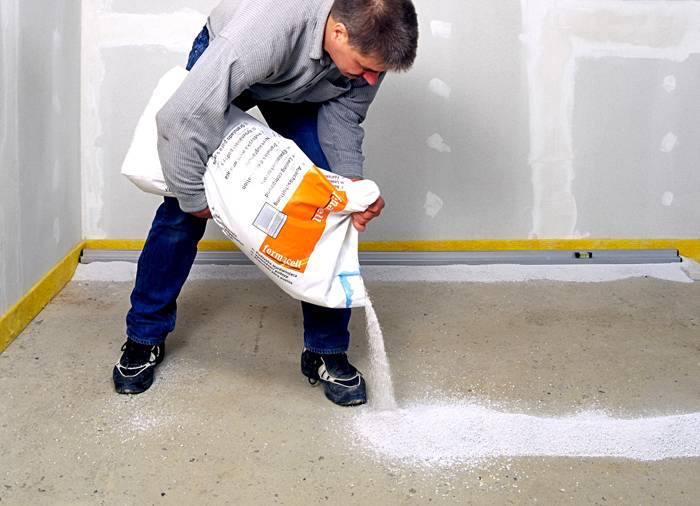
The floor is treated using small bulk materials: expanded clay or coarse perlite sand. The backfill is compacted and covered with gypsum fiber material for strength. Afterwards, the finished floor is installed on top.
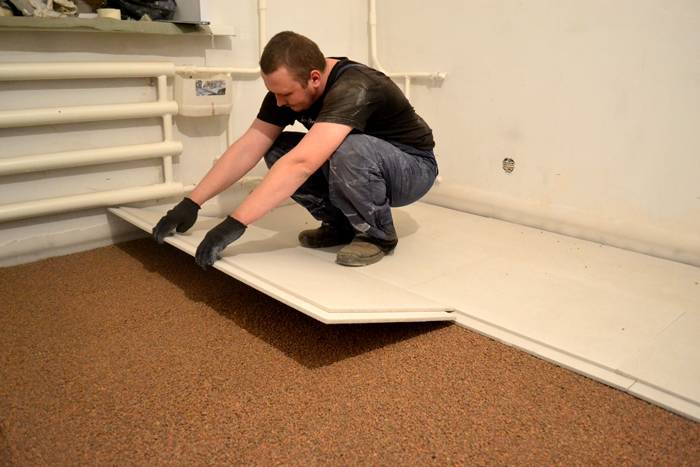
The number of layers and backfill options may vary, depending on the specific requirements of the room.
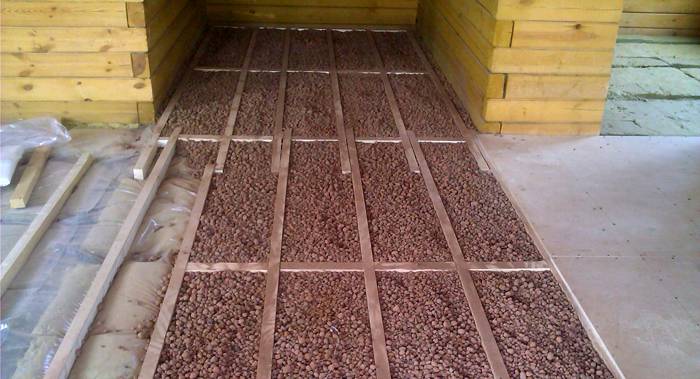
When to use dry screed:
- the difference in floor level is more than four centimeters;
- utility lines in a protective shell are laid along the floor surface;
- for repairing old wooden coverings, including parquet boards;
- if it is necessary to carry out repairs in an extremely short time;
- when working indoors at sub-zero temperatures, when the concrete pour simply won’t stand up.
Quick dry floor screed: pros and cons, reviews, price of ready-mixes
Reviews and price matter when choosing a mixture. Dry floor screed, pros and cons:
Table 1. Disadvantages of technology
| Flaw | Description |
|---|---|
| Does not tolerate contact with water | This leveling method cannot be used on the floors of a bathroom, bathhouse, or kitchen. Ingress of moisture will lead to the formation of mold stains and fungal growths. It is undesirable to install water floor heating systems even with reliable insulation. |
| Has the ability to absorb moisture from the atmosphere | In a cold basement, on a balcony or in a room without heating, the dry mixture will gradually absorb dampness and moisture from the air, which contributes to inevitable damage to the base. |
| Does not tolerate mechanical stress | Backfill does not perform well in rooms with constant mechanical load. If the surface is not compacted tightly enough, the unevenness of the floor will appear again, this will lead to deformation of the laminate or parquet. Under the influence of heavy pieces of furniture and partitions, floors with dry screed tend to press through. |
| Significantly reduces the height of the room | You should especially carefully measure the room before installing the dry screed. Otherwise, the area of the room may be significantly reduced. |
| Increased noise level in the room | Due to the special properties of expanded clay, at first the floors will rustle when moving around the room. This should stop after the final shrinkage of the material. |
| Reproduction of rodents and insects under the floor | In country houses, this deficiency occurs quite often. It is not particularly difficult for animals to make passages and nests under such a floor. In such a situation, you will have to regularly carry out deratization. |
All these nuances should be taken into account and appropriate measures taken when operating the premises.
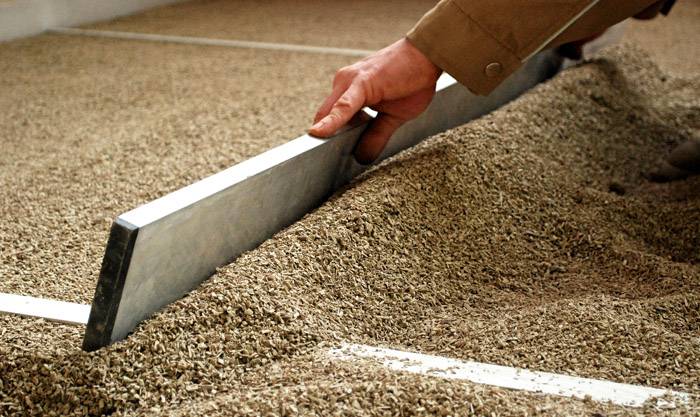
Table 2. Benefits
| Advantages | Description |
|---|---|
| Easy installation | Even a novice master can do this work. Installation does not require the use of special equipment or tools. |
| Speed | The filling itself does not take much time; there is no need to wait for the material to form. Immediately after leveling and compacting, you can lay the finished floor and use the room. |
| No dirt during installation | This, at first glance, insignificant advantage, can only be appreciated in comparison with concrete pouring. |
| Low cost of materials | Savings when installing dry floor screed in an apartment are not only due to the lack of need to hire qualified workers. Low prices for expanded clay and sand, gypsum fiber boards are available to every developer. |
| Light weight | This factor is important for buildings with limited load-bearing structures. The low weight of the screed allows it to be used even in buildings with wooden floors. |
| Excellent heat and sound insulation | The concrete surface is always cold, and the dry screed perfectly retains heat in the room and isolates all unnecessary sounds. |
Dry floor screed: price per square meter
Prices for laying dry screed start at 200 rubles per square meter. For this price you can negotiate with a familiar master. Workers from an official company piglets from 500 rubles, depending on the volume.
The cheapest place to buy regular expanded clay is on the construction market. Ready-made mixtures are available for sale.
Table 3. Average cost of expanded clay
| Image | Name | Manufacturer | Volume, l | Fraction, mm | Price, rub |
|---|---|---|---|---|---|
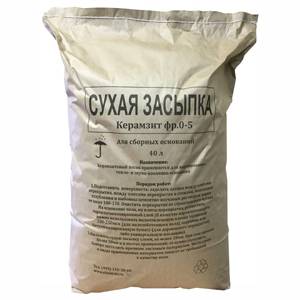 | Dry backfill for floors | Ecoblocks | 40 | 0-5 | 134 |
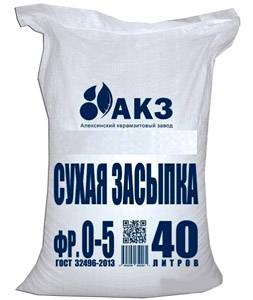 | Expanded clay backfill for prefabricated floors AKZ | AKZ | 40 | 0-5 | 140 |
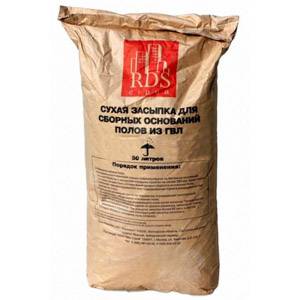 | Expanded clay backfill RDS | RDS Stroy | 50 | 0-5 | 190 |
| Backfill Knauf | Knauf | 40 | 0-5 | 40 |
Table 4. Average cost of gypsum fiber boards
| Image | Name | Manufacturer | Volume, l | Fraction, mm | Price, rub |
|---|---|---|---|---|---|
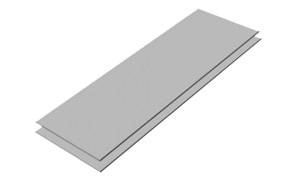 | Moisture-resistant floor element Knauf | Knauf | 1200x600 | 20 | 269 |
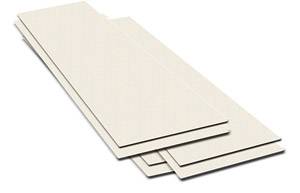 | Knauf gypsum fiber sheet | Knauf | 2500x1200 | 10 | 463 |
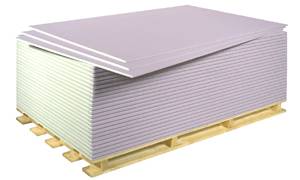 | KNAUF GVL Superfloor gypsum fiber | Knauf | 2500x600 | 20 | 312 |
 | KNAUF GVL gypsum fiber | Knauf | 2500x1200 | 12,5 | 499 |
 | GSPV moisture-resistant gypsum particle board | PGZ | 2500x1250 | 10 | 575 |
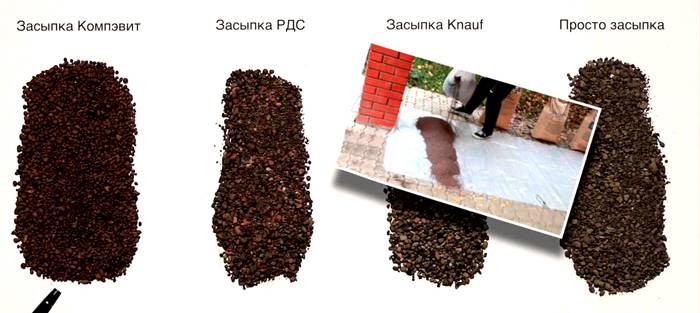
Reviews
Andrey, Engels:“We did a dry screed throughout the house. Much faster, easier and better quality than a “wet” surface. I had a bad experience - they were pouring concrete in an apartment, the workers were sloppy, they stained all the walls, and they poured it crookedly. To top off all the misfortunes in the hall, the screed began to crack. So they decided to just fill the house. No problems, everything is smooth, the floors are warm.”
Igor Sergeevich, Ulyanovsk:“We backfilled the apartment. They just didn’t dare to level the bathroom this way, and I think it was in vain. If you make high-quality waterproofing and put it on top, you can use it there too. Overall impressions are good. For the first week, my wife was worried that the floors were noisy, but now everything has calmed down, we don’t even remember about it.”
Olga, Moscow:“The upstairs neighbors flooded the apartment so much that the furniture was floating. In one room there was a concrete screed, in the second there was a dry screed. After a month, mold appeared on the concrete, and we can’t eradicate it with anything. And they just changed the dry one. They opened up the floors, removed the wet expanded clay, dried it and laid in new ones. No problem".
Dry coating installation
To lay the coating you will need materials and tools:
- expanded clay and sand;
- GVL sheets;
- polyethylene and edge tapes;
- construction adhesive;
- self-tapping screws;
- profile and beacons.
Sequence of work:
- Stage – waterproofing
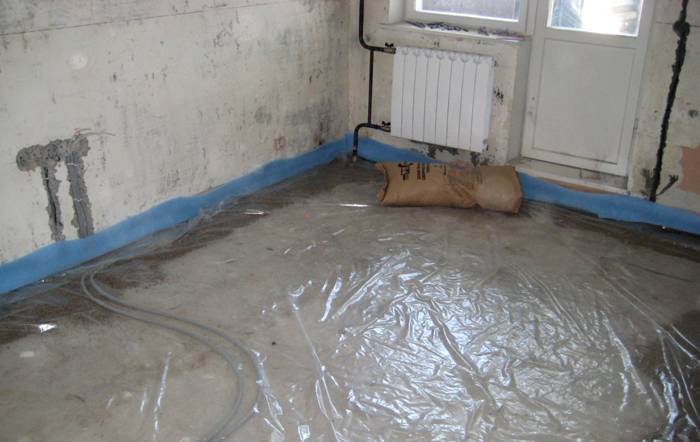
The amount of polyethylene film is calculated based on. It is necessary to provide allowances of about fifteen percent of the length and width. Polyethylene is sold in pipes with a diameter of three meters. It is cut lengthwise and laid overlapping on the floor.
Helpful information! Instead of polyethylene, other water-repellent materials can be used.
- Stage – installation of beacons
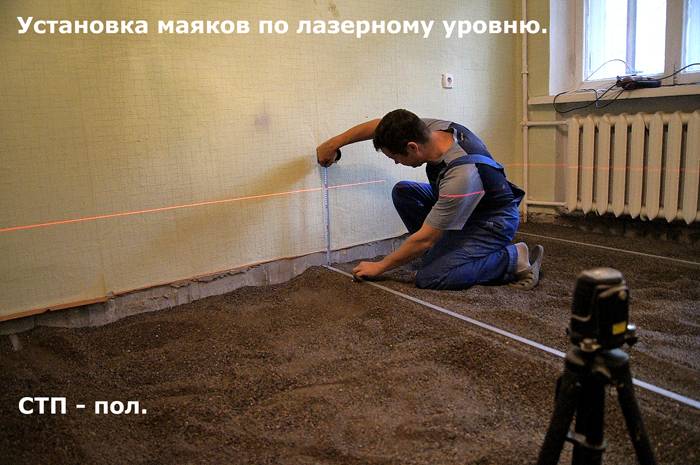
It is advisable to install beacons, but not required. You can lay the profile on the floor and navigate using it. This is a more convenient and reliable option.
- Stage - filling the mixture
It is better to fill the mixture in stages, immediately installing several sheets of gypsum fiber board on top. Otherwise, your feet will get stuck in the backfill, and dirt and dust will spread throughout all the rooms.

- Stage - laying sheet material
The sheets should be laid one at a time, without moving them too hard along the surface of the screed. The weight of the sheet is approximately seventeen kilograms; it is better to hire an assistant to place it. To prevent the end sheet from being buried in the backfill, you need to cut off the fold along the wall.
Each sheet will require about ten screws. GVL is laid offset on the adhesive base.

Helpful information! To work with gypsum fiber sheets, special fasteners are needed; they have a cone-shaped slot.
How to make a dry floor screed with your own hands: video from experts
Useful little things
- If there is still an urgent need to make a dry screed in the kitchen, you should use two layers of waterproofing: on top and below the backfill.
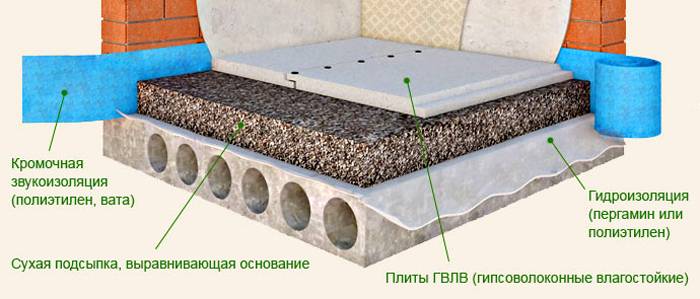
- The tiles can be attached directly to GVL sheets using construction adhesive.
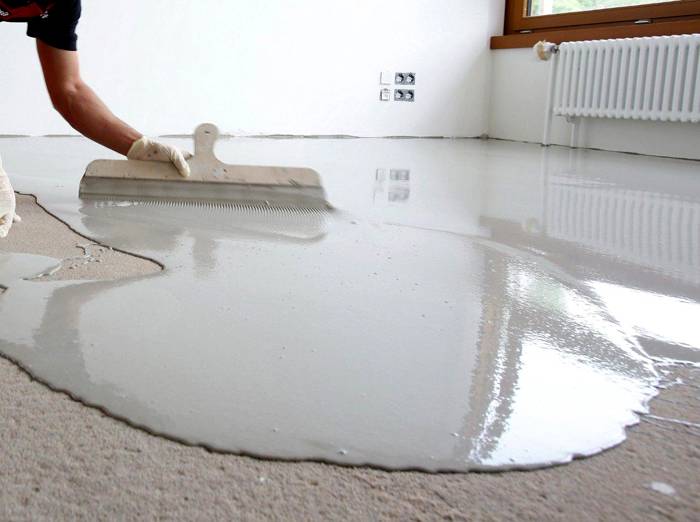
- The joints of linoleum over the dry screed are filled with putty.
- Although dry backfill is ready for operational loads immediately after installation, it is better to let it rest for at least a day so that the glue can properly hold the sheets together.
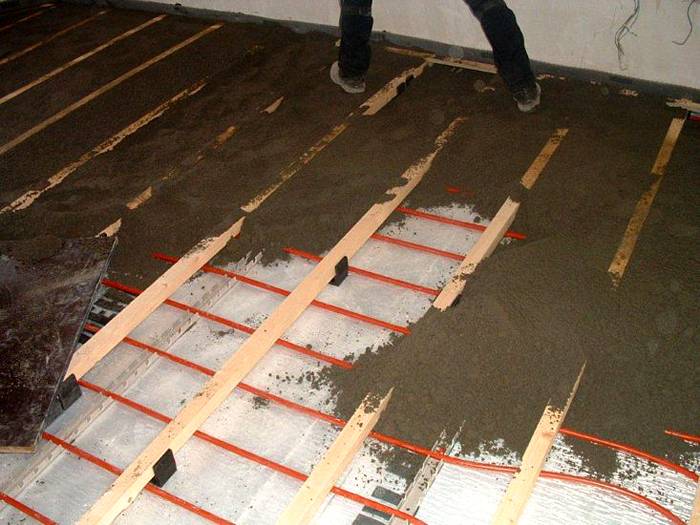
Let's sum it up
We looked at the pros and cons, prices and reviews of using dry floor screed. It cannot be stated unequivocally that this leveling method is the best of the existing ones. It, like any technology, has its own special requirements. If you take them into account and prepare for possible difficulties in advance, you can achieve excellent results. A dry screed will become a reliable heat insulator and will not allow the penetration of extraneous sounds.
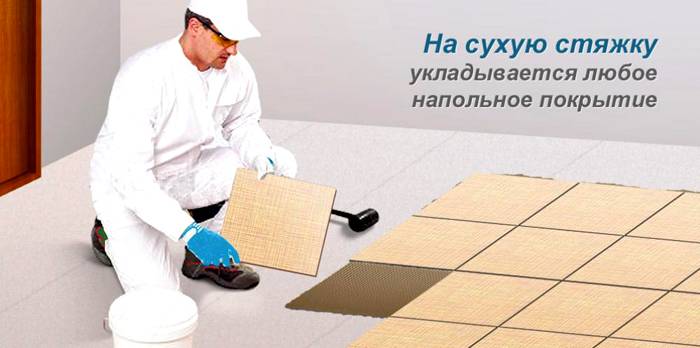
 Masonry mortars for brick kilns
Masonry mortars for brick kilns Why do the windows in the apartment fog up?
Why do the windows in the apartment fog up? Construction and diagrams of brick stoves
Construction and diagrams of brick stoves How to lay paving slabs: tips and tricks
How to lay paving slabs: tips and tricks How to drill tiles in the bathroom
How to drill tiles in the bathroom Monolithic slab on coarse soil
Monolithic slab on coarse soil Which electric heater is economical?
Which electric heater is economical?